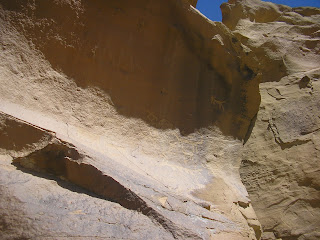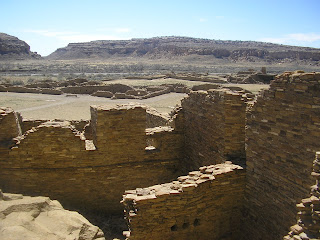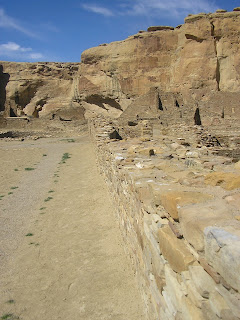Welcome to Chaco Canyon!
Una Vida dwellings, one of the earliest Chacoan Pueblo villages, was constructed from the 850s through the 1250s. Una Vida contains mostly houses.
Petroglyphs on the canyon walls above Una Vida.
Una Vida.
Hungo Pavi was built from the 1000s through the 1250s. It contains mostly homes, like Una Vida, built its buildings are considerably larger.
Fajada Butte in the background.
1,000 year-old wood!
Entering Pueblo Bonito, the largest Chacoan town. Built and occupied from 850 - 1250, Pueblo Bonito was the center of Chaco civilization. Some of the buildings here were as high as 4-5 stories and consisted of over 600 and 40 kivas in total. It does not seem that Pueblo Bonito was a permanent settlement, but was instead a ceremonial gathering place or resort for the rich and famous of Chacoan society. Mexican, American, and other Native American groups have encountered Pueblo Bonito for centuries and reported about it. Pueblo Bonito remains sacred to Pueblo and Hopi Indians.
An example of core-and-veneer walls. The core rocks are consistent in size, but different in shape. The exterior rocks, the veneer, are more uniform in shape and smoothness.
Leroy.
For year, Threatening Rock hovered over Pueblo Bonito. On January 22, 1941, the rock collapsed, destroying many structures and Pueblo Bonito. The rock was 97 feet high, 140 feet long, and 34 feet thick and weighed 30,000 tons. Threatening Rock has since been renamed Fallen Rock.
Fossilized shells from when this area was an ocean.
One of the best views of the grand plazas, kivas, and homes at Pueblo Bonito.
This is the typical thickness of the buildings.
Moving farther into Pueblo Bonito. While the discovery of skeletal remains is sparse, one unearthed grave revealed the most turquoise than at all the other spots in the world...combined.
Pueblo Bonito with the moon hovering above.
Doorways.
The oldest section of Pueblo Bonito.
Great kiva.
The biggest kiva at Pueblo Bonito.
A giant Ponderosa Pine once stood here. Archeologists aren't sure if the tree was religiously significant as the tree of life, or just something nice for shade.
The intersection of these rocks marks the cardinal points. The wall on the left runs exactly north-south, while the other one runs exactly east-west.
Diamond rocks placed in the wall by a medicine man to protect Pueblo Bonito.
Original plastered and painted wall.
One of the cool diagonal windows.
Line of doorways.
House with original wooden roof from 1,000 years ago.
Chetro Ketl, a large pueblo that was built and occupied from 1000s - 1250s.
The largest kiva at Chetro Ketl and at Chaco Canyon overall. About 400 people could participate in ceremonies here.
Following photos courtesy of Melissa Coles
Grave of Richard Wetherill (1858 - 1910). A Colorado rancher, Wetherill was one of the first European-Americans to research Mesa Verde and Chaco Canyon. He was shot and killed in the canyon in a property dispute and is buried a few hundred yards from Pueblo Bonito.
Kin Kletso. A later house, I believe it was built from 1000s - 1250s.
Pueblo del Arroyo, 1000s - 1250s.
Pueblo Bonito.
Shrimp burrows form prehistoric times.
Best views of Pueblo Bonito.



































































































No comments:
Post a Comment